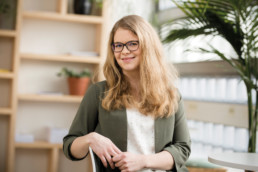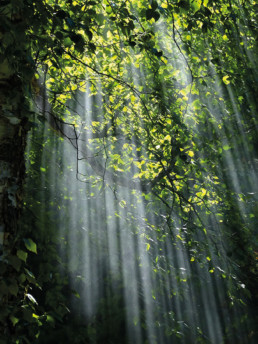WHAT’S THE POINT OF THE CIRCULAR ECONOMY?
In 2020, the amount of man-made material exceeded the amount of biomass on our planet. (1) According to the Circularity Gap report 2022, only 8.6 per cent of all produced material gets recycled globally. (2)In other words, over 90 percent of extracted materials go straight to waste or are used only once. Clearly, we need to do something.
The current unsustainable production and consumption patterns of our society result in materials being used inefficiently and wasted after their first life. Due to this, many of the materials we use today quickly lose their value. In our current economic model, we take more and more materials, produce more products and compensate the lost value by producing larger quantities. This is wasteful and expensive – and harmful for human wellbeing.

Maria Hughes, Specialist The Finnish innovation Fund Sitra.
HOW CAN WE INCREASE THE VALUE OF MATERIALS TO GET MORE WITH LESS?
This is where the circular economy comes into the picture. The circular economy might seem like a hype, but it makes sense. In truth, circular business models have always created revenue for companies.
Solutions that provide services over selling products have a potential to succeed. The manufacturer’s earnings logic encourages the production of high-quality and repairable products with a long lifespan, while the customer no longer needs to take care of updating and maintaining the product. Circular businesses can focus on managing production side streams, producing repairable products with a long lifespan, and refining the value of waste through recycling.
Despite the type of a circular business and its location, the goal is common: gaining revenue by increasing the value of materials by using less raw materials, keeping them in use longer and managing them in an organised manner.
Investors and decision makers are becoming more and more interested in circular business. In the last five years the number of private market funds focusing on the circular economy has jumped ten-fold. (3) Also, many recent policy developments are favourable for the circular economy. In line with its Circular Economy Action Plan, the European Union is developing regulations to ensure longer lifespans and repairability for products to control unsustainable material management. (4)
The message is clear – the circular economy makes sense and provides opportunities for businesses.
“We recently added the SMARTwaste mobile app to Rinki’s tool kit, which makes the system even faster to use. In addition to monitoring fill levels, the app can be used to order service calls and monitor progress. The ability to respond rapidly to fault situations also reduces customer complaints, downtime and costs,” Jussila says.
The system is being continuously developed by Rinki, PROs and Europress. Tanskanen is very satisfied with this cooperation: “We have always had good dialog with Europress, also when dealing with challenging issues. Europress has always been ready to resolve any challenges that arise and has also proactively developed our cooperation. It is important to us that technical issues have been addressed rapidly,” the Rinki CEO says.
Tanskanen also has a message for all the countries where a network of public pick-up points is being set up or renewed. He notes that sufficient time and expertise are needed to set up an extensive network, so the project has to be planned well. The location of eco pick-up points and good communications channels for providing customer feedback are crucial for the development of an effective network. Tanskanen also recommends weighing during emptying, as it is a cost-effective way to optimize logistics and maintain a high level of service.
“Good cooperation is definitely an advantage. It is worth adopting best practices from other countries while also avoiding any pitfalls that have emerged,” Tanskanen encourages.
Maria Hughes works as a specialist at The Finnish Innovation Fund Sitra. She is closely involved in the World Circular Economy Forum (WCEF) and is forever interested in learning about circular economy developments across the globe.

Sitra is a future fund that collaborates with partners from different sectors to research, trial and implement bold new ideas that shape the future. Our aim is a Finland that succeeds as a pioneer in sustainable well-being. Sitra has worked on the circular economy since 2014. Together with its partners Sitra has published circular economy playbooks to support businesses to adopt circular business models. In 2020 Nordic Innovation published the Nordic Circular Economy Playbook, a tangible tool for Nordic businesses to develop circular business.
First photo: Sitra / Miikka Pirinen
Second photo from Pixabay
1 Elhacham E, Ben-Uri L, Grozoyski J, Bar-on Y M and Milo R (2020) Global human-made mass exceeds all living biomass – Nature 588:442–444 https://www.nature.com/articles/s41586-020-3010-5 2 Circle Economy (2022) The Circularity Gap Report 2022, https://www.circularity-gap.world/2022 3 Ellen MacArthur Foundation (2020) Financing the circular economy, https://emf.thirdlight.com/link/17z1dk7idbty-lrrp3s/@/preview/1?o 4 European Commission (2020) COMMUNICATION FROM THE COMMISSION TO THE EUROPEAN PARLIAMENT, THE COUNCIL, THE EUROPEAN ECONOMIC AND SOCIAL COMMITTEE AND THE COMMITTEE OF THE REGIONS A new Circular Economy Action Plan For a cleaner and more competitive EuropeCOM/2020/98 final, https://eur-lex.europa.eu/legal-content/GA/TXT/?uri=CELEX:52020DC0098

